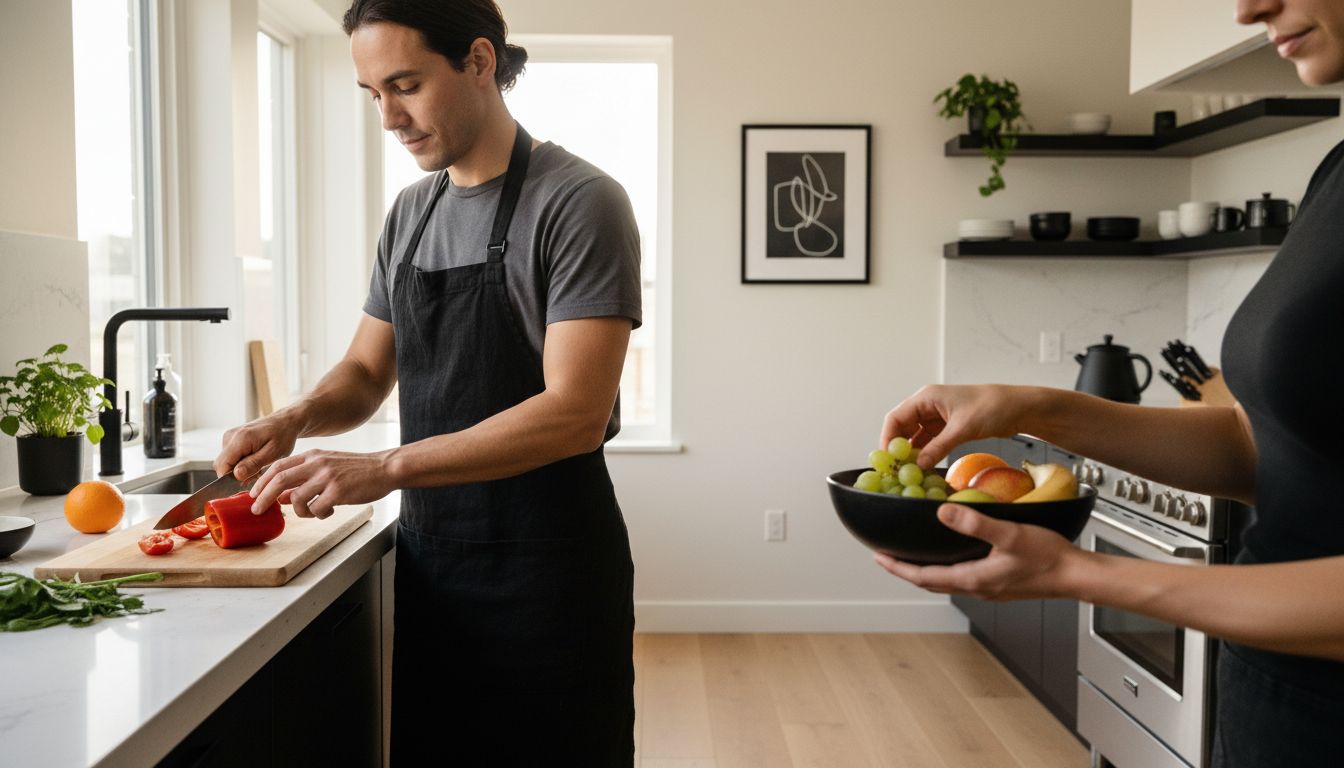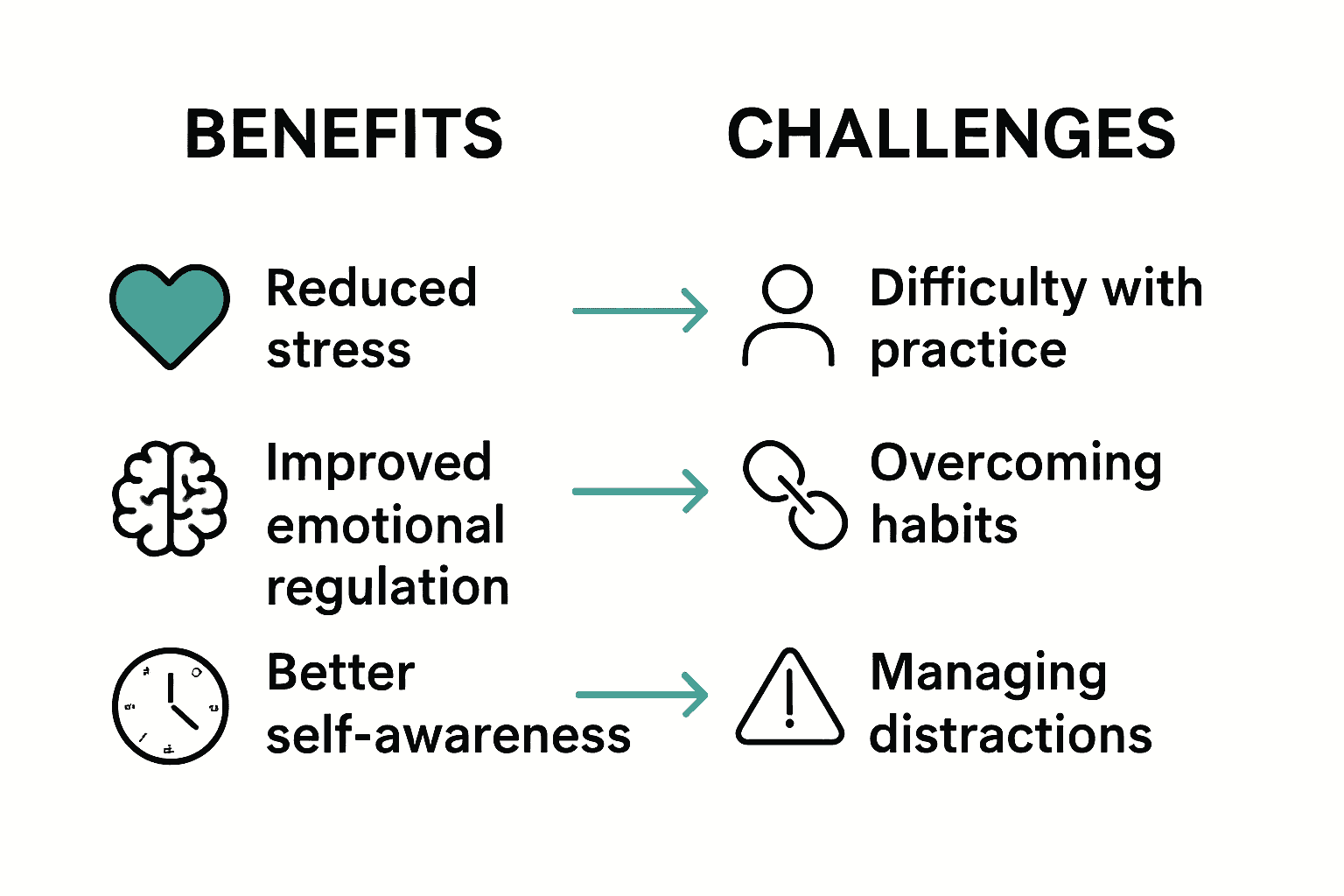
Most people spend nearly half their day thinking about something other than what they are actually doing, according to research from Harvard. This constant distraction takes a toll on mental well-being and quality of life. Mindful living offers a way to reconnect with the present moment and reduce stress, helping you find more clarity and meaning in simple routines. By understanding the core ideas behind mindfulness, you can create habits that bring balance, deeper self-awareness, and greater calm every day.
Table of Contents
- Defining Mindful Living and Its Key Concepts
- Types of Mindful Practices for Daily Life
- Integrating Mindfulness Into Home Organization
- Benefits and Challenges of Mindful Living
- Common Pitfalls and Mistakes to Avoid
Key Takeaways
| Point | Details |
|---|---|
| Mindful Living Principles | Mindful living emphasizes present-moment awareness, non-judgment, and acceptance, encouraging a compassionate relationship with oneself. |
| Types of Mindful Practices | Mindfulness can be practiced formally through structured meditation or informally in daily activities, emphasizing attention regulation and presence. |
| Home Organization | Mindful organization creates intentional spaces to promote mental clarity and emotional well-being, treating organization as a form of self-care. |
| Benefits and Challenges | Mindful living enhances emotional resilience and reduces stress, but maintaining consistent practice can be challenging due to ingrained habits and distractions. |
Defining Mindful Living and Its Key Concepts
Mindful living represents a transformative approach to experiencing life with deliberate, non-judgmental awareness. At its core, mindfulness is about being fully present and engaged in the current moment, rather than getting lost in worries about the future or regrets about the past. According to Buddhist Practice, mindfulness involves maintaining a lucid awareness of bodily and mental phenomena to counter unwholesome states and develop more positive experiences.
The fundamental principles of mindful living emerge from several key psychological and contemplative traditions. University of Alabama at Birmingham researchers have identified core concepts that define this practice, which include:
- Present-moment awareness: Fully experiencing what is happening right now
- Non-judgment: Observing experiences without labeling them as good or bad
- Beginner’s mind: Approaching situations with openness and curiosity
- Patience: Allowing experiences to unfold naturally without forcing outcomes
- Letting be: Accepting circumstances without unnecessary resistance
Practicing mindful living isn’t about achieving perfection but cultivating a compassionate relationship with yourself and your experiences. By integrating these principles into daily routines, individuals can develop greater emotional resilience, reduce stress, and create more meaningful connections with themselves and others. The journey of mindfulness is personal and unique, inviting practitioners to explore their inner landscape with kindness and genuine curiosity.
Types of Mindful Practices for Daily Life
Mindfulness practices offer diverse approaches to cultivating awareness and presence in our daily experiences. Coursera distinguishes between two primary categories of mindfulness: formal and informal practices. Formal practices involve dedicated meditation sessions where individuals intentionally set aside time for focused awareness, while informal practices integrate mindfulness seamlessly into everyday activities.
Formal mindfulness practices typically include:
- Body scan meditation: Systematically focusing attention on different body parts
- Seated meditation: Observing breath and mental states
- Mindful movement: Practices like yoga or tai chi that combine physical motion with awareness
- Guided visualization: Using structured mental imagery to cultivate calm
- Breathing exercises: Deliberately regulating and observing breath patterns
Informal mindfulness practices transform routine activities into opportunities for presence. According to JIBS Research, these can include mindfully performing everyday tasks like washing dishes, folding laundry, or walking. The key is maintaining attention regulation and an open, curious orientation toward the present moment. By bringing full awareness to seemingly mundane activities, practitioners can turn ordinary moments into opportunities for personal growth and inner peace.

The beauty of mindful practices lies in their flexibility and accessibility. Whether you have 5 minutes or an hour, whether you prefer structured meditation or spontaneous awareness, there are mindfulness techniques adaptable to every lifestyle and personality. The goal isn’t perfection but consistent, compassionate practice that gradually transforms your relationship with yourself and your environment.
Integrating Mindfulness Into Home Organization
Mindful home organization transcends simple tidying—it’s about creating intentional spaces that support mental clarity and emotional well-being. Mindful.org suggests that we can transform our living environments by deliberately creating spaces that encourage mindful practices, such as designating specific areas for meditation, reflection, and intentional pause.
Drawing inspiration from architectural principles, ArXiv Research highlights the concept of living structure, which involves organizing spaces with purposeful complexity. This approach goes beyond aesthetic arrangement, focusing on how physical environments can support psychological well-being. Key strategies for mindful home organization include:
- Creating clear, uncluttered surfaces that reduce visual stress
- Establishing dedicated zones for different activities
- Using natural light and minimalist design to promote calmness
- Incorporating elements that spark joy and meaningful connection
- Designing spaces that facilitate smooth, intentional movement
The ultimate goal of mindful home organization is to transform your living space into a sanctuary that supports your mental and emotional journey. By approaching organization as a form of self-care, you create an environment that not only looks orderly but feels nurturing. Each intentional choice—from how you arrange furniture to the items you choose to keep—becomes a meditation on presence and personal values. Learn more about creating wellness spaces in our home organization guide, where we explore how thoughtful design can profoundly impact your daily experience.
Benefits and Challenges of Mindful Living
Mindful living presents a transformative approach to personal growth, offering profound mental and physical benefits while simultaneously presenting unique challenges. ArXiv Research highlights that consistent mindfulness practice can significantly enhance overall well-being, though sustaining long-term commitment requires strategic approaches and personal dedication.
The key benefits of mindful living include:
- Reduced stress and anxiety
- Improved emotional regulation
- Enhanced cognitive flexibility
- Better self-awareness
- Increased resilience to daily challenges
However, practitioners often encounter significant obstacles in maintaining their practice. Cognitive Research suggests that de-automatizing habitual thought patterns requires consistent effort and can trigger internal resistance. Challenges typically involve:
- Difficulty establishing a regular practice
- Overcoming ingrained behavioral patterns
- Managing technological distractions
- Maintaining motivation during challenging periods
- Developing patience with personal progress
Learn more about staying motivated with mindfulness in our guide about having fun while staying tidy, where we explore practical strategies for making mindful living an enjoyable and sustainable journey. The path to mindfulness is not about perfection, but persistent, compassionate self-exploration.

Common Pitfalls and Mistakes to Avoid
Mindfulness is a nuanced practice that requires intentional awareness and gentle self-correction. Mindful.org emphasizes that many individuals inadvertently sabotage their mindfulness journey by rushing through activities without deliberate attention, which ultimately increases stress and reduces the practice’s effectiveness.
Common mindfulness mistakes include:
- Expecting immediate perfection
- Judging yourself harshly during practice
- Treating mindfulness as a performance
- Inconsistent or sporadic practice
- Attempting too much complexity too quickly
- Neglecting self-compassion
Mindful.org suggests that one of the most pervasive pitfalls is engaging in mindless communication. For instance, sending emails or messages without pausing to consider tone and intention can undermine mindful living. The recommended approach involves composing a message, taking a deliberate breath, and then carefully reviewing it for clarity and emotional resonance.
Ultimately, avoiding these pitfalls requires patience, consistent practice, and a compassionate approach to personal growth. Learn more about staying motivated with mindfulness in our guide about having fun while staying tidy, where we explore practical strategies for transforming potential challenges into opportunities for deeper self-understanding.
Transform Your Home into a Mindful Sanctuary Today
Living mindfully means creating spaces that support calm, clarity, and emotional well-being. If clutter and disorganization overwhelm you, it can be hard to fully embrace the key mindful living concepts like present-moment awareness and patience. Our curated storage solutions at Blush Bees help you design intentional, clutter-free environments that promote peace and focus. From versatile storage boxes to stylish baskets and smart dividers, every piece is crafted to bring order and joy to your home.

Start your mindful living journey by transforming your space with high-quality, space-efficient organizers that align with principles like letting be and beginner’s mind. Visit Blush Bees now to explore our collection and take advantage of special offers designed to make your home a true sanctuary. Don’t wait to experience the emotional uplift that a well-organized home can bring—create your mindful environment now by browsing our home organization solutions and embracing a calmer lifestyle.
Frequently Asked Questions
What is mindful living?
Mindful living involves experiencing life with intentional, non-judgmental awareness, focusing on the present moment, and engaging with experiences meaningfully.
How can I integrate mindfulness into my home organization?
You can integrate mindfulness into home organization by creating intentional spaces, minimizing clutter, and using design elements that promote calm and clarity.
What are some formal and informal mindfulness practices I can incorporate daily?
Formal practices include meditation, breathing exercises, and yoga, while informal practices can be as simple as being present during routine tasks like washing dishes or taking a mindful walk.
What are common challenges faced in mindful living?
Common challenges include establishing a regular practice, overcoming distractions, managing expectations of perfection, and maintaining motivation during difficult times.



